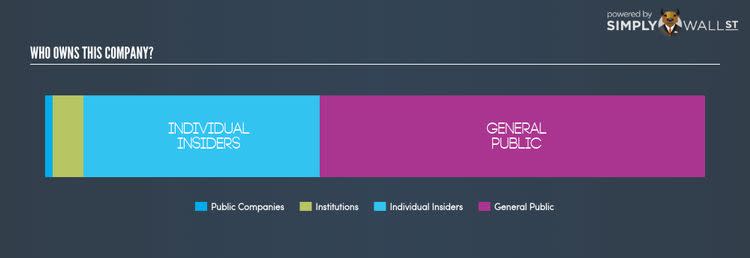Should You Be Concerned About BIO-key International Inc’s (BKYI) Investors?

In this article, I’m going to take a look at BIO-key International Inc’s (NASDAQ:BKYI) latest ownership structure, a non-fundamental factor which is important, but remains a less discussed subject among investors. Ownership structure of a company has been found to affect share performance over time. Since the effect of an active institutional investor with a similar ownership as a passive pension-fund can be vastly different on a company’s corporate governance and accountability of shareholders, investors should take a closer look at XYZ’s shareholder registry. All data provided is as of the most recent financial year end.
Check out our latest analysis for BIO-key International
Institutional Ownership
Institutional investors transact in large blocks which can influence the momentum of stock prices, at least in the short-term, especially when there is a low level of public shares available on the market to trade. With an institutional ownership of 4.67%, BKYI doesn’t seem too exposed to higher volatility resulting from institutional trading. In addition, the fact that the company is covered by only 1 analyst indicates that it is yet to become popular amongst large sell-side institutions. Low coverage stocks like BKYI tend to be favourite picks of legendary investor Peter Lynch, who used to cash in on the rally supported by institutional buying as the stock gained popularity.
Insider Ownership
I find insiders are another important group of stakeholders, who are directly involved in making key decisions related to the use of capital. In essence, insider ownership is more about the alignment of shareholders’ interests with the management. BKYI insiders hold a significant stake of 35.81% in the company. This level of insider ownership has been found to have a negative impact on companies with consistently low PE ratios (underperformers), while it has been positive in the case of high PE ratio firms (outperformers). Another aspect of insider ownership is to learn about their recent transactions. Insiders buying company shares can be a positive indicator of future performance, but a selling decision can simply be driven by personal financial needs.
General Public Ownership
A big stake of 58.29% in BKYI is held by the general public. With this size of ownership, retail investors can collectively play a role in major company policies that affect shareholders returns, including executive remuneration and the appointment of directors. They can also exercise the power to decline an acquisition or merger that may not improve profitability.
Public Company Ownership
Potential investors in BKYI should also look at another important group of investors: other public companies, with a stake of 1.22%, who are primarily invested because of strategic and capital gain interests. However, an ownership of this size may be relatively insignificant, meaning that these shareholders may not have the potential to influence BKYI’s business strategy. Thus, investors not need worry too much about the consequences of these holdings.
What this means for you:
Are you a shareholder? With a low level of institutional ownership, investors in BKYI need not worry about non-fundamental factors such as ownership structure causing large impact on stock prices. Looking for ways to reinforce your current portfolio holdings? Take a look at our free platform for a list of stocks with a strong growth potential.
Are you a potential investor? Ownership structure should not be the only determining factor when you’re building an investment thesis for BKYI. Rather, you should be examining fundamental factors like the intrinsic valuation of BKYI, which is a key driver of BKYI’s share price. Take a look at our most recent infographic report on BKYI for a more in-depth analysis of these factors to help you make a more well-informed investment decision.
NB: Figures in this article are calculated using data from the last twelve months, which refer to the 12-month period ending on the last date of the month the financial statement is dated. This may not be consistent with full year annual report figures.
To help readers see pass the short term volatility of the financial market, we aim to bring you a long-term focused research analysis purely driven by fundamental data. Note that our analysis does not factor in the latest price sensitive company announcements.
The author is an independent contributor and at the time of publication had no position in the stocks mentioned.


